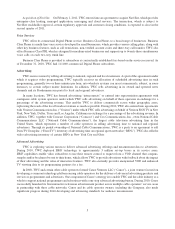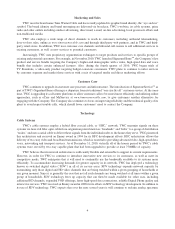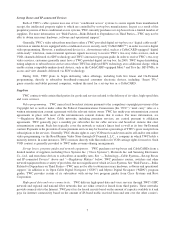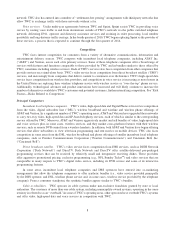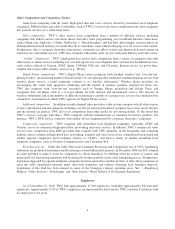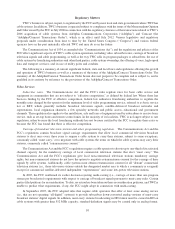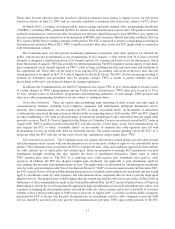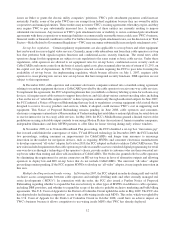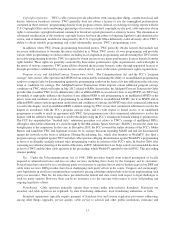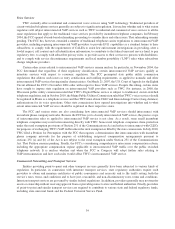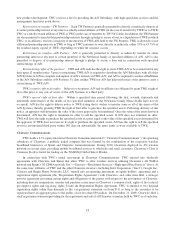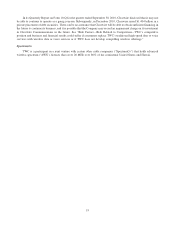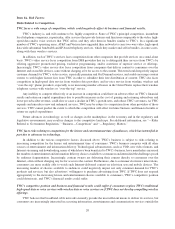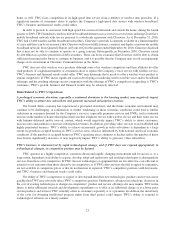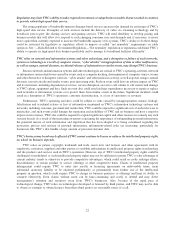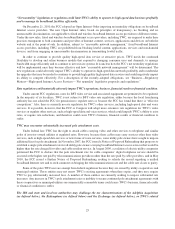Time Warner Cable 2010 Annual Report Download - page 27
Download and view the complete annual report
Please find page 27 of the 2010 Time Warner Cable annual report below. You can navigate through the pages in the report by either clicking on the pages listed below, or by using the keyword search tool below to find specific information within the annual report.In October 2009, the FCC initiated a Notice of Proposed Rulemaking to adopt so-called “net neutrality” or “open
Internet” rules applicable to all providers of broadband Internet access services, whether wireline or wireless. The rules as
proposed would not have applied to providers of applications, content or other services. Subsequently, in response to the
April 2010 decision of the U.S. Court of Appeals for the District of Columbia Circuit overturning the FCC’s August 2008
ruling pursuant to Title I of the Act finding Comcast had violated the FCC’s Net Neutrality Policy Statement, the
FCC adopted a Notice of Inquiry (“NOI”) to explore classifying the transmission component of facilities-based wireline
broadband Internet access service as a Title II common carrier. The NOI only touched on how non-facilities based and
wireless broadband Internet service providers should be regulated and did not address the regulatory framework
applicable to application or content providers, on-line service providers or Internet backbone providers. In
September 2010, the FCC issued a public notice seeking comments on the relationship between its October 2009
proposed net neutrality regulations and “managed” or “specialized” services that are provided over the same last-mile
facilities as broadband Internet access service. On December 21, 2010, the FCC adopted an Open Internet Order pursuant
to its Title I authority imposing net neutrality obligations on broadband Internet access providers, including TWC. While
the Order specifically indicates that the FCC pursued the exercise of Title I jurisdiction in lieu of a Title II reclassification
approach, the NOI addressing a Title II reclassification nevertheless remains pending.
The new Open Internet rules are based on three basic principles: transparency, no blocking, and no unreasonable
discrimination, and are applicable to fixed and wireless broadband Internet access providers to different extents. Under
the new rules, fixed and wireless broadband Internet access providers are required to make their practices transparent to
both consumers and providers of Internet content, services, applications, and devices on both their website and at the
point-of-sale. In addition, subject to “reasonable network management”, fixed broadband Internet access providers are
prohibited from blocking lawful content, applications, services, and non-harmful devices, and from engaging in
unreasonable discrimination in transmitting lawful traffic. The new rules specifically do not apply to “managed” or
“specialized” services that share the same network infrastructure as broadband Internet access services, although the
Order indicates that the FCC intends to observe market developments in this area and may take further regulatory action if
it believes it is warranted. These rules do not become effective until 60 days after the Federal Register notice announcing
the Office of Management and Budget’s decision regarding the information collection requirements associated with the
new rules. Although these steps have not yet occurred, two parties have already filed challenges to the Order in the
U.S. Court of Appeals for the District of Columbia Circuit.
For further discussion of “net neutrality” and its impact on TWC, see the discussion in “Risk Factors—Risks Related
to Government Regulation—‘Net neutrality’ legislation or regulation could limit TWC’s ability to operate its high-speed
data business profitably and to manage its broadband facilities efficiently.”
National Broadband Plan. As part of the American Recovery and Reinvestment Act of 2009, Congress directed the
FCC to develop a National Broadband Plan, which was delivered to Congress on March 16, 2010. The plan focuses
primarily on universal broadband deployment, increased broadband utilization and adoption, and the integration of
broadband into several key “national purposes,” such as healthcare, education, energy and E-government, and the plan
includes over 200 recommendations to ensure that every American has affordable access to, and an understanding of,
broadband capability. The recommendations focus on four areas: broadband competition policy to maximize innovation,
investment and consumer benefits; fixed and mobile broadband infrastructure to facilitate more deployment and
upgrades; Universal Service Fund (“USF”) reform to support high-cost deployment, affordability, adoption and
utilization of broadband services; and increasing reliance on broadband for achieving America’s national priorities to
incorporate broadband into all sectors of the economy through federal, state, local and tribal governments.
On April 6, 2010, the FCC released its 2010 Broadband Action Agenda setting out the purpose and timing of more
than 60 rulemakings and other notice-and-comment proceedings to implement the recommendations of the National
Broadband Plan intended to accelerate the deployment and adoption of robust, affordable broadband for all Americans; to
help 100 million U.S. homes get affordable access to actual download speeds of at least 100 megabits over the next
decade; to promote innovation, investment, competition and consumer interests throughout the broadband ecosystem; and
to advance the use of broadband for key national priorities, including public safety, health care and education. The
FCC has commenced numerous proceedings in accordance with the Broadband Action Agenda, and TWC is actively
participating in many of these proceedings, including those addressing USF reform, consumer disclosure and
transparency, network reliability and survivability and pole attachments. TWC is unable to predict the impact of
such proceedings on TWC’s business.
15


